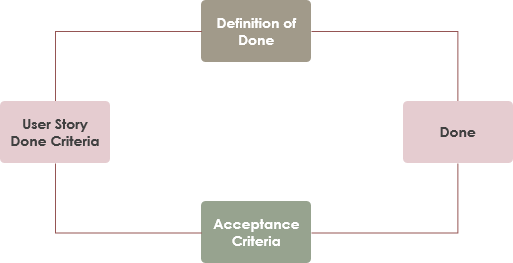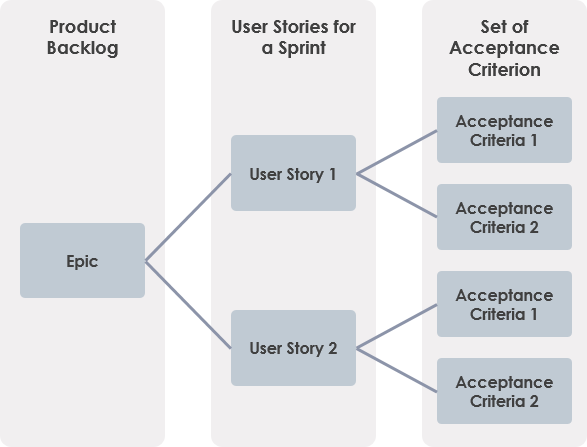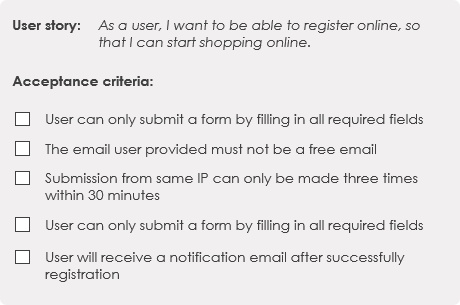định nghĩa hoàn thành (DoD) là danh sách các yêu cầu mà câu chuyện người dùng phải tuân thủ để nhóm có thể coi nó là hoàn thành.
tiêu chí chấp nhận cho các câu chuyện người dùng bao gồm một tập hợp các kịch bản kiểm tra sẽ đáp ứng các yêu cầu để xác nhận xem phần mềm hoạt động như mong đợi hay không.
Khi nào câu chuyện người dùng sẽ được hoàn thành?
Nói cách khác, để hoàn thành các câu chuyện người dùng, DOD và tiêu chí chấp nhận phải được đáp ứng. Các phần tăng trưởng sản phẩm không được coi là hoàn thành trừ khi cả hai danh sách đều hoàn thành. Do đó, chúng ta cần xác định hai khía cạnh của định nghĩa DoD — tiêu chí hoàn thành và tiêu chí chấp nhận:

Định nghĩa hoàn thành
Định nghĩa hoàn thành được cấu trúc dưới dạng danh sách các mục, mỗi mục được sử dụng để xác thực một Câu chuyện hoặc PBI, nhằm đảm bảo rằng Nhóm Phát triển đồng ý về chất lượng công việc mà họ đang cố gắng sản xuất. Nó phục vụ như một danh sách kiểm tra được sử dụng để kiểm tra mỗi Danh sách sản phẩm Mục (còn gọi là PBI) hoặc Câu chuyện người dùng để hoàn chỉnh. Các mục trong định nghĩa “Hoàn thành” được dự định áp dụng cho tất cả các mục trong Danh sách sản phẩm, không chỉ một Câu chuyện người dùng duy nhất.
Nó có thể được tóm tắt như sau:
- Thuật ngữ này áp dụng nhiều hơn cho phần tăng trưởng sản phẩm nói chung
- Trong hầu hết các trường hợp, thuật ngữ này ngụ ý rằng phần tăng trưởng sản phẩm có thể được giao hàng
- Thuật ngữ này được định nghĩa trong Hướng dẫn Scrum
- Được sử dụng như một cách để giao tiếp giữa các thành viên trong nhóm
- Chất lượng phần mềm tổng thể
- Liệu phần tăng trưởng có thể giao hàng hay không
Ví dụ — Định nghĩa hoàn thành
- Mã đã được xem xét đồng nghiệp chưa?
- Mã đã hoàn thành chưa?
- Mã đã được xem xét chưa?
- Mã đã được kiểm tra chưa?
- Các bài kiểm tra đơn vị đã vượt qua chưa?
- Các bài kiểm tra chức năng đã vượt qua chưa?
- Các bài kiểm tra chấp nhận đã hoàn thành chưa?
- Chủ sở hữu sản phẩm đã được xem xét và chấp nhận chưa?
Tiêu chí chấp nhận
Các câu chuyện người dùng là một trong những tài liệu phát triển chínhtài liệu cho phát triển Agile, nhưng Scrum không yêu cầu rõ ràng việc sử dụng Câu chuyện người dùng hoặc Tiêu chí chấp nhận. Nếu một mục trong danh sách sản phẩm được coi là quá lớn để đưa vào một sprint, nó sẽ thường được chia nhỏ thành câu chuyện người dùng và sau đó thành một tập hợp các nhiệm vụ như được hiển thị trong Hình:

Các câu chuyện người dùng bao gồm các tiêu chí chấp nhận, do đó chúng ta thường thấy định nghĩa hoàn thành và tiêu chí chấp nhận cùng tồn tại trong quy trình phát triển scrum của chúng ta. Câu chuyện người dùng cung cấp bối cảnh về chức năng mà nhóm nên cung cấp. Tiêu chí chấp nhận cung cấp hướng dẫn về chi tiết của chức năng đó và cách mà khách hàng sẽ chấp nhận chúng. Cả hai cùng nhau cung cấp toàn bộ sản phẩm giao hàng.
Một số Tiêu chí chấp nhận sẽ được phát hiện trong các sự kiện Tinh chỉnh Danh sách đang diễn ra trước khi Sprint bắt đầu, và những cái khác sẽ được phát hiện ngay sau Lập kế hoạch Sprint khi ngồi xuống để có một cuộc trò chuyện về câu chuyện người dùng trong một nhóm nhỏ. Vì vậy, Tiêu chí chấp nhận là các thuộc tính độc đáo cho Câu chuyện người dùng hoặc Mục Danh sách sản phẩm.
- Thuật ngữ này áp dụng cho một PBI/Câu chuyện cá nhân
- Tiêu chí chấp nhận khác nhau cho mỗi PBI/Câu chuyện
- Thuật ngữ này không được định nghĩa trong Hướng dẫn Scrum
- Được sử dụng như một cách để thông báo cho tất cả những người liên quan rằng các yêu cầu cho một PBI/câu chuyện cụ thể đã được đáp ứng
- Còn gọi là Các bài kiểm tra chấp nhận, Điều kiện thỏa mãn, trong một số trường hợp là “Các trường hợp kiểm tra,” v.v.
Ví dụ về Câu chuyện người dùng với Tiêu chí chấp nhận
Hình dưới đây cho thấy một ví dụ về tiêu chí chấp nhận của một câu chuyện người dùng.

This post is also available in Deutsch, English, Español, فارسی, Français, Bahasa Indonesia, 日本語, Polski, Portuguese, Ру́сский, 简体中文 and 繁體中文.













